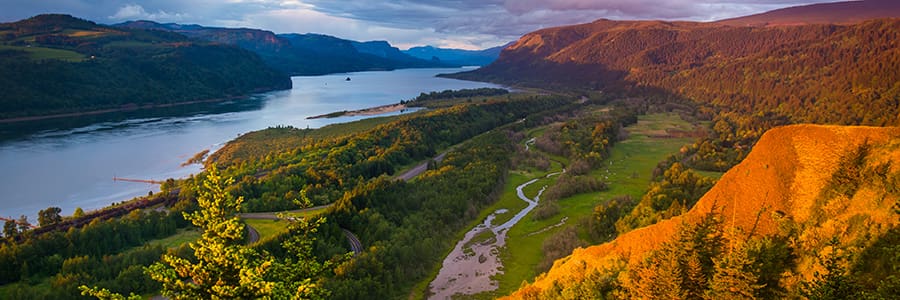
About The Columbia & Snake Rivers
The Columbia was named after a fur-trading vessel, the Columbia Rediviva, helmed by American ship captain Robert Gray, the first explorer to enter the river, in May of 1792.
The largest river in the Pacific Northwest at 1,243 long, the Columbia River rises in the Rocky Mountains of British Columbia, Canada, flowing northwest and then south into the U.S. state of Washington, where it turns west to form most of the border between Washington and Oregon before emptying into the Pacific Ocean via a drainage basin roughly the size of France. River Cruises on the Columbia often continue on to the Snake River in eastern Oregon as well for a complete Columbia & Snake River experience.
The duo of the Columbia and its tributary, the Snake River, is one of the most popular river cruise itineraries in the United States. Overflowing with history and gorgeous natural landmarks like the Columbia River Gorge and Hells Canyon, North America’s deepest river gorge, this was the territory first explored by Lewis and Clark. Today, wine connoisseurs are drawn by the increasingly popular Pacific Northwest wines that are produced here.
The best cruise lines operating on the Columbia and Snake rivers are American Cruise Lines, American Queen Steamboat Company, Lindblad Expeditions-National Geographic, and Un-Cruise Adventures. Cruises along the river operate from April to November, with springs generally green and rainy, summers hot, and fall a favorite time for most travelers, with grapes on the vines and foliage bursting into glorious color.
Columbia & Snake River Stats
Length: 1,243 miles
Depth: Maximum of 55 feet
Source: Columbia Lake, British Columbia, Canada
Mouth: Pacific Ocean, Oregon, USA
Locks: 4
Countries: Canada | United States of America
Learn More About the Columbia and Snake Rivers of the United States
The Columbia and Snake Rivers are two of the most iconic waterways in the western United States, offering a unique blend of natural beauty, ecological significance, and human history. Spanning thousands of miles and draining vast regions of North America, these rivers have played a central role in the development of the Pacific Northwest, from their majestic landscapes to their influence on industry, agriculture, and culture.
Geography and Origins
The Columbia River is the largest river in the Pacific Northwest, flowing over 1,200 miles from its source in British Columbia, Canada, to the Pacific Ocean in Oregon. It drains an expansive watershed that includes parts of seven U.S. states and one Canadian province. The Snake River, one of the Columbia’s largest tributaries, stretches over 1,000 miles from Wyoming to its confluence with the Columbia in Washington.
Ecological Significance
The Columbia and Snake Rivers are renowned for their ecological diversity. The river basin hosts an array of species, including salmon, steelhead trout, sturgeon, and many more. Historically, these rivers were prime spawning grounds for salmon, contributing to one of the most significant salmon runs in the world. However, the construction of dams, particularly on the Columbia, has significantly altered the river’s ecosystems and impacted fish populations.
Dams and Hydroelectric Power
The Columbia and Snake Rivers are home to numerous dams, some of which serve as critical sources of hydroelectric power. The Grand Coulee Dam on the Columbia River, for instance, is one of the largest concrete structures in the United States and generates vast amounts of electricity. These dams have been instrumental in providing power to the region and facilitating irrigation for agriculture but have also caused significant ecological disruptions, including the obstruction of fish migrations.
Navigation and Transportation
The Columbia and Snake Rivers have long been vital transportation routes. Native American tribes, such as the Nez Perce and Chinook, used these rivers for millennia for trade and travel. In the 19th century, European-American explorers and settlers, including Lewis and Clark, ventured into the region using these waterways. Today, the Columbia-Snake River system is a critical corridor for shipping goods from the inland states to the Pacific Ocean, with many ports and harbors along its banks.
Agriculture and Irrigation
The fertile valleys along these rivers have given rise to some of the most productive agricultural regions in the United States. The Columbia Basin in Washington and the Snake River Plain in Idaho are known for their abundant crops, including wheat, potatoes, apples, and more. Irrigation systems fed by the rivers have transformed arid landscapes into lush farmlands.
Challenges and Conservation
The Columbia and Snake Rivers face significant challenges in the modern era. The construction of dams has led to the decline of salmon and steelhead populations, leading to efforts to restore fish habitats and migration routes. Water quality and pollution concerns have also arisen, prompting conservation efforts to protect these vital water resources.
Recreation and Tourism
The beauty of the Columbia and Snake Rivers draws millions of visitors each year. The Columbia River Gorge, with its stunning waterfalls and hiking trails, is a popular destination. Water sports like rafting, kayaking, and fishing are also prevalent, and the rivers offer scenic routes for cruising and exploring the region.
Cultural Significance
The Columbia and Snake Rivers have profound cultural significance for the indigenous peoples of the region. Native American tribes have lived along these rivers for thousands of years, and their traditions and connection to the land continue to be an integral part of the area’s culture. The rivers have also inspired artists, writers, and poets, capturing the imagination of those who have been touched by their grandeur.
